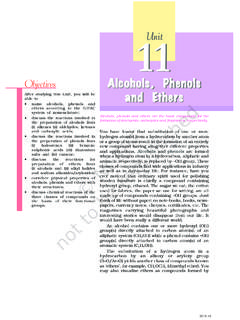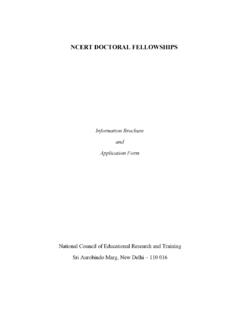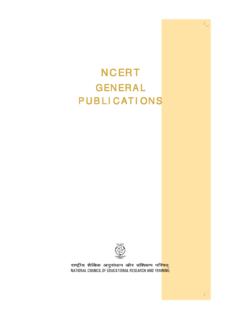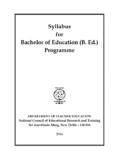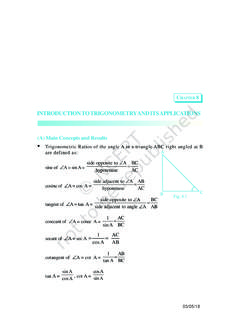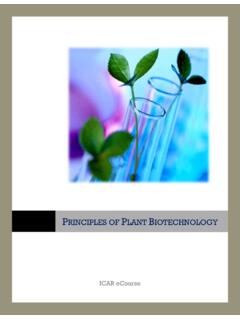Transcription of Biotechnology and its Applications
1 CHAPTER 12. Biotechnology AND ITS. Applications . Biotechnological Applications in Agriculture Biotechnology , as you would have learnt from the previous chapter, essentially deals with industrial scale Biotechnological production of biopharmaceuticals and biologicals using Applications in genetically modified microbes, fungi, plants and animals. Medicine The Applications of Biotechnology include therapeutics, Transgenic Animals diagnostics, genetically modified crops for agriculture, processed food, bioremediation, waste treatment, and Ethical Issues energy production.
2 Three critical research areas of Biotechnology are: (i) Providing the best catalyst in the form of improved organism usually a microbe or pure enzyme. (ii) Creating optimal conditions through engineering for a catalyst to act, and (iii) Downstream processing technologies to purify the protein/organic compound. Let us now learn how human beings have used Biotechnology to improve the quality of human life, especially in the field of food production and health. B IOTECHNOLOGICAL A PPLICATIONS IN. AGRICULTURE. Let us take a look at the three options that can be thought for increasing food production (i) agro-chemical based agriculture.
3 2021 22. BIOLOGY. (ii) organic agriculture; and (iii) genetically engineered crop-based agriculture. The Green Revolution succeeded in tripling the food supply but yet it was not enough to feed the growing human population. Increased yields have partly been due to the use of improved crop varieties, but mainly due to the use of better management practices and use of agrochemicals (fertilisers and pesticides). However, for farmers in the developing world, agrochemicals are often too expensive, and further increases in yield with existing varieties are not possible using conventional breeding.
4 Is there any alternative path that our understanding of genetics can show so that farmers may obtain maximum yield from their fields? Is there a way to minimise the use of fertilisers and chemicals so that their harmful effects on the environment are reduced? Use of genetically modified crops is a possible solution. plants , bacteria, fungi and animals whose genes have been altered by manipulation are called Genetically Modified Organisms (GMO). GM. plants have been useful in many ways. genetic modification has: (i)made crops more tolerant to abiotic stresses (cold, drought, salt, heat).
5 (ii)reduced reliance on chemical pesticides (pest-resistant crops). (iii)helped to reduce post harvest losses. (iv) increased efficiency of mineral usage by plants (this prevents early exhaustion of fertility of soil). (v) enhanced nutritional value of food, , golden rice, , Vitamin A'. enriched rice. In addition to these uses, GM has been used to create tailor-made plants to supply alternative resources to industries, in the form of starches, fuels and pharmaceuticals. Some of the Applications of Biotechnology in agriculture that you will study in detail are the production of pest resistant plants , which could decrease the amount of pesticide used.
6 Bt toxin is produced by a bacterium called Bacillus thuringiensis (Bt for short). Bt toxin gene has been cloned from the bacteria and been expressed in plants to provide resistance to insects without the need for insecticides; in effect created a bio-pesticide. Examples are Bt cotton, Bt corn, rice, tomato, potato and soyabean etc. Bt Cotton: Some strains of Bacillus thuringiensis produce proteins that kill certain insects such as lepidopterans (tobacco budworm, armyworm), coleopterans (beetles) and dipterans (flies, mosquitoes).
7 B. thuringiensis 208 forms protein crystals during a particular phase of their growth. These crystals contain a toxic insecticidal protein. Why does this toxin not kill the Bacillus? Actually, the Bt toxin protein exist as inactive protoxins but once an insect ingest the inactive toxin, it is converted into an active form of toxin due to the alkaline pH of the gut which solubilise the crystals. The activated toxin binds to the surface of midgut epithelial cells and 2021 22. Biotechnology AND ITS Applications . create pores that cause cell swelling and lysis and eventually cause death of the insect.
8 Specific Bt toxin genes were isolated from Bacillus thuringiensis and incorporated into the several crop plants such as cotton (Figure ). The choice of genes depends upon the crop and the targeted pest, as most Bt toxins are insect-group specific. The toxin is coded by a gene cryIAc named cry. There are a number of them, for example, the proteins encoded by the genes cryIAc and cryIIAb control the cotton bollworms, that of cryIAb controls corn borer. (a). (b). Figure Cotton boll: (a) destroyed by bollworms; (b) a fully mature cotton boll Pest Resistant plants : Several nematodes parasitise a wide variety of plants and animals including human beings.
9 A nematode Meloidegyne incognitia infects the roots of tobacco plants and causes a great reduction in yield. A novel strategy was adopted to prevent this infestation which was based on the process of RNA interference (RNAi). RNAi takes place in all eukaryotic organisms as a method of cellular defense. This method involves silencing of a specific mRNA due to a complementary dsRNA. molecule that binds to and prevents translation of the mRNA (silencing). The source of this complementary RNA could be from an infection by viruses having RNA genomes or mobile genetic elements (transposons).
10 That replicate via an RNA intermediate. 209. Using Agrobacterium vectors, nematode-specific genes were introduced into the host plant (Figure ). The introduction of DNA. was such that it produced both sense and anti-sense RNA in the host cells. These two RNA's being complementary to each other formed a double stranded (dsRNA) that initiated RNAi and thus, silenced the specific mRNA. 2021 22. BIOLOGY. of the nematode. The consequence was that the parasite could not survive in a transgenic host expressing specific interfering RNA.
